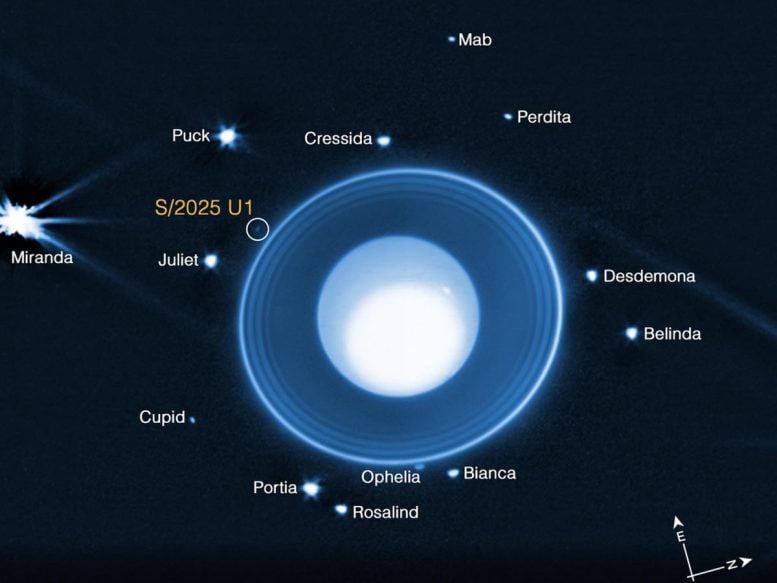
The James Webb Space Telescope has spotted a tiny, hidden moon orbiting Uranus that even Voyager 2 missed during its 1986 flyby.
The newfound satellite, only about six miles wide, becomes Uranus’ 29th known moon and orbits near the planet’s inner rings. Its discovery highlights Webb’s extraordinary ability to uncover small, faint objects in the outer solar system, while adding a new member to Uranus’ Shakespeare-inspired celestial family.
Discovery of a New Uranian Moon
Scientists from the Southwest Research Institute (SwRI) have used the James Webb Space Telescope (JWST) to identify a previously unknown moon orbiting Uranus. The discovery, made by a team led by Dr. Maryame El Moutamid, came from images captured on February 2, 2025. With this addition, Uranus is now known to have 29 moons.
“As part of JWST’s guest observer program, we found a previously unknown satellite of the ice giant, which has been provisionally designated S/2025 U 1,” said El Moutamid, a lead scientist in SwRI’s Solar System Science and Exploration Division in Boulder, Colorado. “This object, by far the smallest object discovered to date, was detected in a series of 10 long exposures obtained by the Near-Infrared Camera.”

The Sideways Planet’s Unique Nature
Uranus, the seventh planet from the Sun, lies in the distant reaches of the solar system. Often called “the sideways planet” because of its unusual tilt, Uranus is a cyan-colored ice giant with an atmosphere rich in hydrogen, helium, and methane. Researchers believe its larger moons are composed of roughly equal amounts of water ice and silicate rock.
“Assuming that the new moon has an albedo comparable to other nearby satellites, this object is probably around six miles (10 km) in diameter,” El Moutamid said. “It is well below the detection threshold for the Voyager 2 cameras.”
This timelapse animation shows the newly discovered moon of Uranus, designated S/2025 U1, as well as 13 of the 28 other known moons orbiting the planet.
Voyager 2’s Historic Flyby
The only spacecraft ever to visit Uranus is Voyager 2, which made its closest approach on January 24, 1986, passing within about 50,000 miles of the planet’s upper clouds. During its flyby, Voyager 2 gathered thousands of images that revealed Uranus’ ring system and uncovered several small moons, including 10 that were later given official names.
Uranus’ 28 moons include five major moons — Titania, Oberon, Umbriel, Ariel, and Miranda — discovered between 1787 and 1948. Known as “the literary moons,” Uranus’s satellites are named for characters in Shakespeare and the works of Alexander Pope.

Orbit and Neighboring Moons
The new moon is at the edge of Uranus’ inner rings. It is located about 35,000 miles (56,250 km) from its center in the planet’s equatorial plane, between the orbits of Ophelia and Bianca. Ophelia is about 13 miles (43 km) in diameter, while Bianca is an elongated object around 40 by 29 miles (64 by 46 km) in dimension.
“With so many of Uranus’ moons named for Shakespearean characters, our team is getting a lot of culture trying to figure out what to name our new discovery,” El Moutamid said.
Never miss a breakthrough: Join the SciTechDaily newsletter.
2 Comments
they should name it Saint-Exupéry
after the author of The Little Prince <3
I think you should name it Dingleberry.